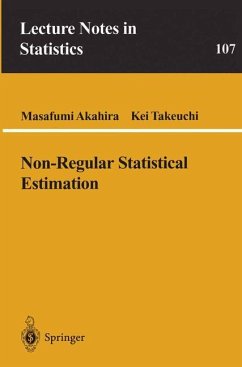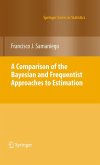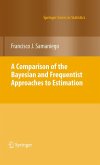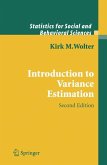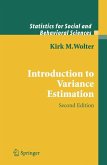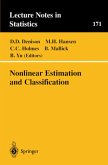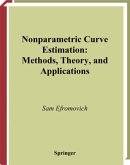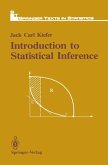- Broschiertes Buch
- Merkliste
- Auf die Merkliste
- Bewerten Bewerten
- Teilen
- Produkt teilen
- Produkterinnerung
- Produkterinnerung
In order to obtain many of the classical results in the theory of statistical estimation, it is usual to impose regularity conditions on the distributions under consideration. In small sample and large sample theories of estimation there are well established sets of regularity conditions, and it is worth while to examine what may follow if any one of these regularity conditions fail to hold. "Non-regular estimation" literally means the theory of statistical estimation when some or other of the regularity conditions fail to hold. In this monograph, the authors present a systematic study of the…mehr
Andere Kunden interessierten sich auch für
![A Comparison of the Bayesian and Frequentist Approaches to Estimation A Comparison of the Bayesian and Frequentist Approaches to Estimation]() Francisco J. SamaniegoA Comparison of the Bayesian and Frequentist Approaches to Estimation75,99 €
Francisco J. SamaniegoA Comparison of the Bayesian and Frequentist Approaches to Estimation75,99 €![A Comparison of the Bayesian and Frequentist Approaches to Estimation A Comparison of the Bayesian and Frequentist Approaches to Estimation]() Francisco J. SamaniegoA Comparison of the Bayesian and Frequentist Approaches to Estimation75,99 €
Francisco J. SamaniegoA Comparison of the Bayesian and Frequentist Approaches to Estimation75,99 €![Introduction to Variance Estimation Introduction to Variance Estimation]() Kirk WolterIntroduction to Variance Estimation149,99 €
Kirk WolterIntroduction to Variance Estimation149,99 €![Introduction to Variance Estimation Introduction to Variance Estimation]() Kirk WolterIntroduction to Variance Estimation153,99 €
Kirk WolterIntroduction to Variance Estimation153,99 €![Nonlinear Estimation and Classification Nonlinear Estimation and Classification]() D.D. Denison / M. Hansen / C.C. Holmes / B. Mallick / B. Yu (eds.)Nonlinear Estimation and Classification39,99 €
D.D. Denison / M. Hansen / C.C. Holmes / B. Mallick / B. Yu (eds.)Nonlinear Estimation and Classification39,99 €![Nonparametric Curve Estimation Nonparametric Curve Estimation]() Sam EfromovichNonparametric Curve Estimation75,99 €
Sam EfromovichNonparametric Curve Estimation75,99 €![Introduction to Statistical Inference Introduction to Statistical Inference]() Jack C. KieferIntroduction to Statistical Inference62,99 €
Jack C. KieferIntroduction to Statistical Inference62,99 €-
-
-
In order to obtain many of the classical results in the theory of statistical estimation, it is usual to impose regularity conditions on the distributions under consideration. In small sample and large sample theories of estimation there are well established sets of regularity conditions, and it is worth while to examine what may follow if any one of these regularity conditions fail to hold. "Non-regular estimation" literally means the theory of statistical estimation when some or other of the regularity conditions fail to hold. In this monograph, the authors present a systematic study of the meaning and implications of regularity conditions, and show how the relaxation of such conditions can often lead to surprising conclusions. Their emphasis is on considering small sample results and to show how pathological examples may be considered in this broader framework.
Produktdetails
- Produktdetails
- Lecture Notes in Statistics Vol.107
- Verlag: Springer / Springer New York / Springer, Berlin
- Artikelnr. des Verlages: 978-0-387-94578-1
- 1995.
- Seitenzahl: 196
- Erscheinungstermin: 18. August 1995
- Englisch
- Abmessung: 235mm x 155mm x 11mm
- Gewicht: 298g
- ISBN-13: 9780387945781
- ISBN-10: 0387945784
- Artikelnr.: 09222875
- Herstellerkennzeichnung
- Springer-Verlag GmbH
- Tiergartenstr. 17
- 69121 Heidelberg
- ProductSafety@springernature.com
- Lecture Notes in Statistics Vol.107
- Verlag: Springer / Springer New York / Springer, Berlin
- Artikelnr. des Verlages: 978-0-387-94578-1
- 1995.
- Seitenzahl: 196
- Erscheinungstermin: 18. August 1995
- Englisch
- Abmessung: 235mm x 155mm x 11mm
- Gewicht: 298g
- ISBN-13: 9780387945781
- ISBN-10: 0387945784
- Artikelnr.: 09222875
- Herstellerkennzeichnung
- Springer-Verlag GmbH
- Tiergartenstr. 17
- 69121 Heidelberg
- ProductSafety@springernature.com
1. General discussions on unbiased estimation.- 1.1. Formulation.- 1.2. Undominated case.- 1.3. The support depending on the parameter.- 1.4. Discrete parameter set.- 1.5. Discontinuous and non-differentiable density.- 1.6. Non square-integrable likelihood ratio.- 1.7. Asymptotic theory for non-regular cases.- 1.8. Asymptotic Bayes posterior distribution of the parameter in non-regular cases.- 1.9. Overview.- 2. Lower bound for the variance of unbiased estimators.- 2.1. Minimum variance.- 2.2. Bhattacharyya type bound for the variance of unbiased estimators in non-regular cases.- 2.3. Lower bound for the variance of unbiased estimators for one-directional distributions.- 2.4. A second type of one-directional distribution and the lower bound for the variance of unbiased estimators.- 2.5. Locally minimum variance unbiased estimation.- 3. Amounts of information and the minimum variance unbiased estimation.- 3.1. Fisher information and the minimum variance unbiased estimation.- 3.2. Examples on unbiased estimators with zero variance.- 3.3. A definition of the generalized amount of information.- 3.4. Examples on the generalized amount of information.- 3.5. Order of consistency.- 4. Loss of information associated with the order statistics and related estimators in the case of double exponential distributions.- 4.1. Loss of information of the order statistics.- 4.2. The asymptotic loss of information.- 4.3. Proofs of Theorems in Section 4.2.- 4.4. Discretized likelihood estimation.- 4.5. Second order asymptotic comparison of the discretized likelihood estimator with others.- 5. Estimation of a common parameter for pooled samples from the uniform distributions and the double exponential distributions.- 5.1. Estimators of a common parameter for the uniform distributions.- 5.2. Comparison of the quasi-MLE, the weighted estimator and others for the uniform distributions.- 5.3. Estimators of a common parameter for the double exponential distributions.- 5.4. Second order asymptotic comparison of the estimators for the double exponential distributions.- 6. Higher order asymptotics in estimation for two-sided Weibull type distributions.- 6.1. The 2?-th order asymptotic bound for the distribution of 2?-th order AMU estimators.- 6.2. Proofs of Lemmas and Theorem in Section 6.1.- 6.3. The 2?-th order asymptotic distribution of the maximum likelihood estimator.- 6.4. The amount of the loss of asymptotic information of the maximum likelihood estimator.- 7. "3/2-th" and second order asymptotics of the generalized Bayes estimators for a family of truncated distributions.- 7.1. Definitions and assumptions.- 7.2. Generalized Bayes estimators for a family of truncated distributions.- 7.3. Second order asymptotic bound in symmetrically truncated densities.- 7.4. Maximum probability estimation.- 7.5. Examples.- 7.6. Some remarks.- Supplement. The bound for the asymptotic distribution of estimators when the maximum order of consistency depends on the parameter.- 5.1. Order of consistency depending on the parameter.- 5.2. The bound for the asymptotic distribution of AMU estimators in the autoregressive process.- References.
1. General discussions on unbiased estimation.- 1.1. Formulation.- 1.2. Undominated case.- 1.3. The support depending on the parameter.- 1.4. Discrete parameter set.- 1.5. Discontinuous and non-differentiable density.- 1.6. Non square-integrable likelihood ratio.- 1.7. Asymptotic theory for non-regular cases.- 1.8. Asymptotic Bayes posterior distribution of the parameter in non-regular cases.- 1.9. Overview.- 2. Lower bound for the variance of unbiased estimators.- 2.1. Minimum variance.- 2.2. Bhattacharyya type bound for the variance of unbiased estimators in non-regular cases.- 2.3. Lower bound for the variance of unbiased estimators for one-directional distributions.- 2.4. A second type of one-directional distribution and the lower bound for the variance of unbiased estimators.- 2.5. Locally minimum variance unbiased estimation.- 3. Amounts of information and the minimum variance unbiased estimation.- 3.1. Fisher information and the minimum variance unbiased estimation.- 3.2. Examples on unbiased estimators with zero variance.- 3.3. A definition of the generalized amount of information.- 3.4. Examples on the generalized amount of information.- 3.5. Order of consistency.- 4. Loss of information associated with the order statistics and related estimators in the case of double exponential distributions.- 4.1. Loss of information of the order statistics.- 4.2. The asymptotic loss of information.- 4.3. Proofs of Theorems in Section 4.2.- 4.4. Discretized likelihood estimation.- 4.5. Second order asymptotic comparison of the discretized likelihood estimator with others.- 5. Estimation of a common parameter for pooled samples from the uniform distributions and the double exponential distributions.- 5.1. Estimators of a common parameter for the uniform distributions.- 5.2. Comparison of the quasi-MLE, the weighted estimator and others for the uniform distributions.- 5.3. Estimators of a common parameter for the double exponential distributions.- 5.4. Second order asymptotic comparison of the estimators for the double exponential distributions.- 6. Higher order asymptotics in estimation for two-sided Weibull type distributions.- 6.1. The 2?-th order asymptotic bound for the distribution of 2?-th order AMU estimators.- 6.2. Proofs of Lemmas and Theorem in Section 6.1.- 6.3. The 2?-th order asymptotic distribution of the maximum likelihood estimator.- 6.4. The amount of the loss of asymptotic information of the maximum likelihood estimator.- 7. "3/2-th" and second order asymptotics of the generalized Bayes estimators for a family of truncated distributions.- 7.1. Definitions and assumptions.- 7.2. Generalized Bayes estimators for a family of truncated distributions.- 7.3. Second order asymptotic bound in symmetrically truncated densities.- 7.4. Maximum probability estimation.- 7.5. Examples.- 7.6. Some remarks.- Supplement. The bound for the asymptotic distribution of estimators when the maximum order of consistency depends on the parameter.- 5.1. Order of consistency depending on the parameter.- 5.2. The bound for the asymptotic distribution of AMU estimators in the autoregressive process.- References.

